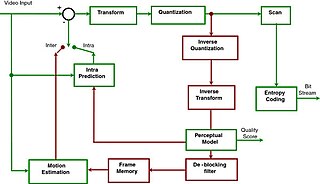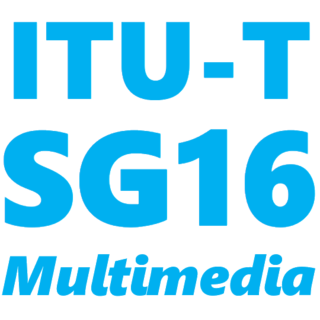H.263 is a video compression standard originally designed as a low-bit-rate compressed format for videotelephony. It was standardized by the ITU-T Video Coding Experts Group (VCEG) in a project ending in 1995/1996. It is a member of the H.26x family of video coding standards in the domain of the ITU-T.

The Moving Picture Experts Group (MPEG) is an alliance of working groups established jointly by ISO and IEC that sets standards for media coding, including compression coding of audio, video, graphics, and genomic data; and transmission and file formats for various applications. Together with JPEG, MPEG is organized under ISO/IEC JTC 1/SC 29 – Coding of audio, picture, multimedia and hypermedia information.

A video codec is software or hardware that compresses and decompresses digital video. In the context of video compression, codec is a portmanteau of encoder and decoder, while a device that only compresses is typically called an encoder, and one that only decompresses is a decoder.

Advanced Video Coding (AVC), also referred to as H.264 or MPEG-4 Part 10, is a video compression standard based on block-oriented, motion-compensated coding. It is by far the most commonly used format for the recording, compression, and distribution of video content, used by 91% of video industry developers as of September 2019. It supports a maximum resolution of 8K UHD.
H.261 is an ITU-T video compression standard, first ratified in November 1988. It is the first member of the H.26x family of video coding standards in the domain of the ITU-T Study Group 16 Video Coding Experts Group. It was the first video coding standard that was useful in practical terms.
The Video Coding Experts Group or Visual Coding Experts Group is a working group of the ITU Telecommunication Standardization Sector (ITU-T) concerned with standards for compression coding of video, images, audio signals, biomedical waveforms, and other signals. It is responsible for standardization of the "H.26x" line of video coding standards, the "T.8xx" line of image coding standards, and related technologies.
The macroblock is a processing unit in image and video compression formats based on linear block transforms, typically the discrete cosine transform (DCT). A macroblock typically consists of 16×16 samples, and is further subdivided into transform blocks, and may be further subdivided into prediction blocks. Formats which are based on macroblocks include JPEG, where they are called MCU blocks, H.261, MPEG-1 Part 2, H.262/MPEG-2 Part 2, H.263, MPEG-4 Part 2, and H.264/MPEG-4 AVC. In H.265/HEVC, the macroblock as a basic processing unit has been replaced by the coding tree unit.
Gary Joseph Sullivan is an American electrical engineer who led the development of the AVC, HEVC, and VVC video coding standards and created the DirectX Video Acceleration (DXVA) API/DDI video decoding feature of the Microsoft Windows operating system. He is currently Director of Video Research and Standards at Dolby Laboratories and is the chair of ISO/IEC JTC 1/SC 29 and of the ITU-T Video Coding Experts Group (VCEG).
Context-adaptive binary arithmetic coding (CABAC) is a form of entropy encoding used in the H.264/MPEG-4 AVC and High Efficiency Video Coding (HEVC) standards. It is a lossless compression technique, although the video coding standards in which it is used are typically for lossy compression applications. CABAC is notable for providing much better compression than most other entropy encoding algorithms used in video encoding, and it is one of the key elements that provides the H.264/AVC encoding scheme with better compression capability than its predecessors.
The Network Abstraction Layer (NAL) is a part of the H.264/AVC and HEVC video coding standards. The main goal of the NAL is the provision of a "network-friendly" video representation addressing "conversational" and "non conversational" applications. NAL has achieved a significant improvement in application flexibility relative to prior video coding standards.
Multi view Video Coding is a stereoscopic video coding standard for video compression that allows for encoding of video sequences captured simultaneously from multiple camera angles in a single video stream. It uses the 2D plus Delta method and is an amendment to the H.264 video compression standard, developed jointly by MPEG and VCEG, with contributions from a number of companies, primarily Panasonic and LG Electronics.
High Efficiency Video Coding (HEVC), also known as H.265 and MPEG-H Part 2, is a video compression standard designed as part of the MPEG-H project as a successor to the widely used Advanced Video Coding. In comparison to AVC, HEVC offers from 25% to 50% better data compression at the same level of video quality, or substantially improved video quality at the same bit rate. It supports resolutions up to 8192×4320, including 8K UHD, and unlike the primarily 8-bit AVC, HEVC's higher fidelity Main 10 profile has been incorporated into nearly all supporting hardware.
Michael J. Horowitz is an American electrical engineer who actively participated in the creation of the H.264/MPEG-4 AVC and H.265/HEVC video coding standards. He is co-inventor of flexible macroblock ordering (FMO) and tiles, essential features in H.264/MPEG-4 AVC and H.265/HEVC, respectively. He is managing partner of Applied Video Compression and has served on the technical advisory boards of Vivox, Inc., Vidyo, Inc., and RipCode, Inc.
A video coding format is a content representation format of digital video content, such as in a data file or bitstream. It typically uses a standardized video compression algorithm, most commonly based on discrete cosine transform (DCT) coding and motion compensation. A specific software, firmware, or hardware implementation capable of compression or decompression in a specific video coding format is called a video codec.
Coding tree unit (CTU) is the basic processing unit of the High Efficiency Video Coding (HEVC) video standard and conceptually corresponds in structure to macroblock units that were used in several previous video standards. CTU is also referred to as largest coding unit (LCU).
MPEG-H is a group of international standards under development by the ISO/IEC Moving Picture Experts Group (MPEG). It has various "parts" – each of which can be considered a separate standard. These include a media transport protocol standard, a video compression standard, an audio compression standard, a digital file format container standard, three reference software packages, three conformance testing standards, and related technologies and technical reports. The group of standards is formally known as ISO/IEC 23008 – High efficiency coding and media delivery in heterogeneous environments. Development of the standards began around 2010, and the first fully approved standard in the group was published in 2013. Most of the standards in the group have been revised or amended several times to add additional extended features since their first edition.
The YCoCg color model, also known as the YCgCo color model, is the color space formed from a simple transformation of an associated RGB color space into a luma value and two chroma values called chrominance green (Cg) and chrominance orange (Co). It is supported in video and image compression designs such as H.264/MPEG-4 AVC, HEVC, VVC, JPEG XR, and Dirac. It is simple to compute, has good transform coding gain, and can be losslessly converted to and from RGB with fewer bits than are needed with other color models. A reversible scaled version with even lower bit depth, YCoCg-R, is also supported in most of these designs and is also used in Display Stream Compression. The more complete definition with variable bit depths of Y and chrominance values is given in ITU-T H.273.

The Fraunhofer Institute for Telecommunications, Heinrich Hertz Institute, HHI, also known as Fraunhofer HHI or Fraunhofer Heinrich Hertz Institute, is an organization of the Fraunhofer Society based in Berlin. The institute engages in applied research and development in the fields of physics, electrical engineering and computer sciences.
Versatile Video Coding (VVC), also known as H.266, ISO/IEC 23090-3, and MPEG-I Part 3, is a video compression standard finalized on 6 July 2020, by the Joint Video Experts Team (JVET), a joint video expert team of the VCEG working group of ITU-T Study Group 16 and the MPEG working group of ISO/IEC JTC 1/SC 29. It is the successor to High Efficiency Video Coding. It was developed with two primary goals – improved compression performance and support for a very broad range of applications.

The ITU-T Study Group 16 (SG16) is a statutory group of the ITU Telecommunication Standardization Sector (ITU-T) concerned with multimedia coding, systems and applications, such as video coding standards. It is responsible for standardization of the "H.26x" line of video coding standards, the "T.8xx" line of image coding standards, and related technologies, as well as various collaborations with the World Health Organization, including on safe listing (H.870) accessibility of e-health (F.780.2), it is also the parent body of VCEG and various Focus Groups, such as the ITU-WHO Focus Group on Artificial Intelligence for Health and its AI for Health Framework.





